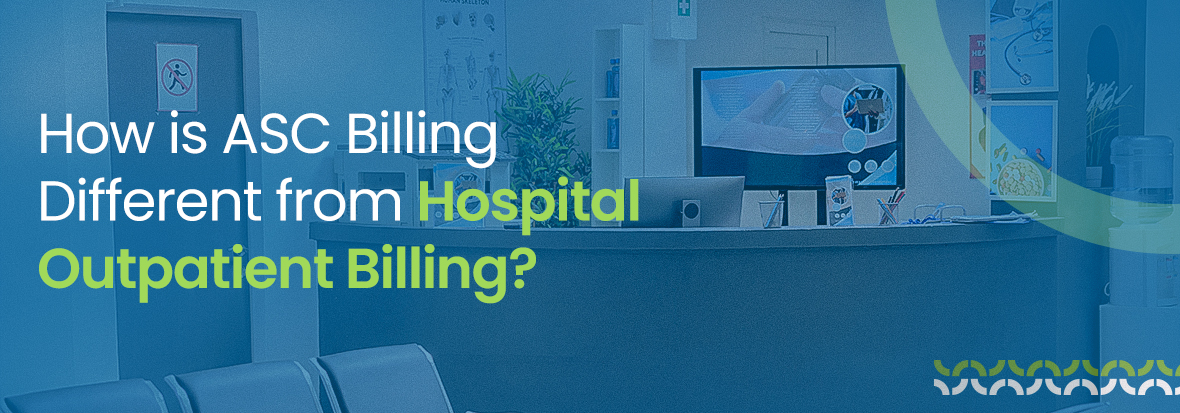The percentage of outpatient surgery has risen significantly over the last few years. For providers, the difference between ASC billing and Outpatient surgery billing matters a lot. It affects things like how fast you get paid, how clean your claims are, and even how much patients pay.
In ASCs, a specialized ASC billing process is used. It’s faster and clearer. You use CPT codes and sometimes modifiers, like -SG. The goal is accurate billing that gets paid well under ASC reimbursement rules. In hospital medical billing, it’s more complex. You follow the OPPS, use APCs, fill out UB-04 forms, and include more detailed hospital coding. That means more steps and more work, but it covers a wider range of services.
This difference matters because knowing the right billing path helps you get paid correctly and reduces headaches with claims. Additionally, it helps you select the optimal setting for each procedure.
Struggling with denials, delays, or underpayments in ASC billing?
What Is ASC Billing & Hospital Outpatient Billing?
| Ambulatory Billing Service | Hospital Outpatient Surgery Billing |
| ASC billing refers to submitting and managing claims for surgical procedures performed in freestanding, non-hospital facilities. These centers focus on same-day surgeries, where patients are discharged on the same day. | Hospital outpatient billing applies to surgeries or procedures done in a hospital’s outpatient department. These settings are often equipped for more complex cases or patients who need closer monitoring. |
The Difference Between ASC & Hospital Outpatient Departments
What are they?
An ASC is a standalone place just for same-day surgeries. It’s not part of a hospital, and it focuses on outpatient care. Patients go in, get treated, and go home the same day. These places are usually much smaller than hospitals.
On the other hand, a hospital outpatient department is part of a full hospital. It offers many services like diagnosis, tests, and minor surgery. It’s inside a bigger building that also treats patients who stay overnight.
Who runs them and how are they regulated?
ASCs are generally run on their own. They may be owned by doctors who work there or by private companies. Medicare decides which surgeries ASCs can do. These must be low-risk and safe for same-day recovery.
HOPDs follow hospital rules. They must follow the hospital’s legal, medical, and safety standards under different regulations.
Focus and experience
ASCs specialize in a few, simpler surgeries. This focus helps them work fast and provide personal care. A small, dedicated team means less waiting and better attention for patients.
Hospital outpatient departments offer more services and cover a bigger range of health needs. Some can use advanced technology like robotics and imaging, which might be helpful for more complicated cases.
Safety
Both ASCs and HOPDs are safe because they follow rules and are regularly checked. If an ASC needs to treat something more complex or if a patient cannot go home after surgery, they can transfer them to a nearby hospital.
How Is Payment Different Between ASC Billing & Hospital Outpatient Billing?
Different Payment Systems
- Hospital Outpatient Departments (HOPDs) use the Outpatient Prospective Payment System (OPPS), which groups services into clusters called Ambulatory Payment Classifications (APCs) and pays hospitals under that system.
- Ambulatory Surgery Centers (ASCs) use a separate ASC fee schedule, which is tied to OPPS but has its own payment rules and rates.
ASCs Get Lower Reimbursements
- ASCs often receive only 50% to 60% of the payment that HOPDs get for the same procedure.
- Medicare pays around 53% of the HOPD rate when care is provided in an ASC.
Why ASCs Get Less: Three Key Factors
Relative Weight
- This is a number assigned by CMS that reflects the effort or resources a service needs. ASCs typically have a lower relative weight than HOPDs, meaning they start with a smaller base for payment.
Conversion Factor
- HOPDs and ASCs use this multiplier to turn relative weights into dollar amounts. ASCs now use a hospital market basket, which tends to give better value, but payments are still lower overall.
Wage Index Adjustment
- This adjusts payments based on local labor costs. HOPDs typically get 60% of this adjustment, while ASCs get only 50%, reducing their reimbursements further.
Facility Fees Are Lower, but Doctor Fees Stay the Same
- Studies show that doctor fees are the same whether a procedure is done in an ASC or HOPD. However, the facility fees for ASCs are significantly lower.
- For example, a colonoscopy in an HOPD might cost around $1,766, while in an ASC it might be $1,089, about 38% less, with the doctor’s fee being the same in both settings.
Commercial Pricing Mirrors Medicare Trends
- Commercial insurers also use separate facility and doctor payments. The facility fee in an ASC is lower, just like with Medicare, which makes ASC visits cheaper overall.
Why These Differences Matter?
- Lower facility fees at ASCs mean savings for both patients and payers.
- For instance, Medicare saves $951 per cataract surgery in an ASC versus $1,691 in a hospital outpatient unit. Converting just one ASC could mean $740 more per surgery and potentially millions more annually.
- Higher HOPD prices: Some services are as much as five times more expensive in HOPDs compared to ASCs or physicians.
| Feature | Hospital Outpatient Department (HOPD) | Ambulatory Surgery Center (ASC) |
|---|---|---|
| Payment System | OPPS + APC-based payments | ASC-specific fee schedule tied to, but lower than, OPPS |
| Reimbursement Level | Higher rates for the same procedure | Lower rates (~50–60%) of HOPD level |
| Geographic Wage Adjustments | Wage index applied via OPPS methodology | Wage index applied; 50% labor weighting in structure |
| Scope of Procedures | Broader range, including complex services | Restricted by the ASC Covered Procedures List |
| Device-Intensive Handling | Packaged via OPPS | Split device vs non-device; specific rate methodology |
| Hospital Coding & Edits | Subject to NCCI outpatient edits | Subject to NCCI, including physician edits |
| Site-Neutral Trends | Higher scrutiny for the extra facility fee | Seen as a cost-effective alternative, target of site-neutral reforms |
| Regulatory Control | OPPS is governed by CMS rulemaking | 42 CFR Part 416 & ASC Quality Reporting Program |
| Service Scope | Broad, includes emergency, diagnostic, outpatient and inpatient prep | Narrow, limited to low-risk, same-day surgical procedures |
| Patient Safety & Transfers | Can handle higher-risk surgeries and overnight stays | Limited, must transfer high-risk or overnight-care cases |
| Billing Transparency | Uses charge masters, opaque pricing | Transparent fee schedules, generally lower costs |
What is the Difference between Insurance Dynamics & Payer Trends in ASCs and HOPDs?
Pricing Across Settings
- Insurance plans, like Medicare and commercial insurers, pay less for the same procedures when done in ASCs compared to HOPDs. That’s because facility fees at ASC sites are lower, even though the doctor’s fee stays the same in both places. So, total payments tend to be much lower at ASCs.
- For example, a colonoscopy may cost around $1,766 in a hospital outpatient department but only $1,089 in an ASC, which is approximately 38% cheaper.
- Blue Cross Blue Shield reports that HOPD prices can be up to five times higher than in ASCs or physician offices. Over time, HOPD pricing has also grown faster, reaching a 27% increase, compared to 11% for ASCs.
Commercial Market & Payer Shifts
- Commercial payers and high-deductible health plans love ASCs because they help reduce costs significantly. Some payers are even requiring certain procedures to be performed in ASCs to save money.
- In Massachusetts, ASC pricing is lower, and patients pay less cost-sharing. For example, cost sharing for a colonoscopy is around 12% lower, and cataract surgery is about 7% lower.
Medicare Fee-For-Service (FFS) Impacts
- Medicare also reimburses less when surgeries happen in ASCs, about half the rate of HOPDs. That creates significant savings for the program and patients.
- In fact, shifting more procedures to ASCs could save taxpayers many billions. Between 2019 and 2028, Medicare could save up to $73.4 billion if migration continues at current rates.
Trends Toward Value-Based Care
- ASCs are becoming a favorite for value-focused payers. They offer efficient, lower-cost environments and outcomes that match, or sometimes exceed, HOPDs. That makes them great fits for value-based care (VBC) contracts.
- General insurers and policymakers are pushing for site-neutral payment policies, paying the same amount for the same care no matter where it’s done. That could bring big savings.
Procedure Shifts in the Market
- More high-acuity procedures (like joint replacements and advanced cardiac operations) are moving into ASCs. Big health systems report strong growth, like a 50% jump in joint cases in a single quarter at some ASC networks.
- Lower-risk procedures like cataract removal or minor orthopedic work are increasingly done in office-based settings. Payers often pay better rates for those, too, encouraging the trend.
Why These Insurance Trends Matter?
- For Payers & Insurers: They save more with ASCs. Medicare spending is lower, and private plans reduce cost growth by steering patients to ASCs or office settings.
- For Providers: ASCs offer more control and efficiency. Surgeons often favor them, and payers support them because of cost and quality benefits.
- For Policymakers & System Balance: Encouraging safe migration of procedures to ASCs is a potential way to control rising healthcare costs. But hospitals argue HOPDs serve important public health roles and must remain viable.
Did You Know an ASC Can Also Be an HOPD?
It might sound surprising, but under certain conditions, an Ambulatory Surgery Center (ASC) can be considered a Hospital Outpatient Department (HOPD).
Here’s how it works:
An ASC can be classified as an HOPD if it meets both of these requirements:
- Location: It’s located within 35 miles of the hospital.
- Shared Operations: It operates under the same financial and administrative agreements as the hospital.
Final Words
ASCs and HOPDs may offer the same procedures, but billing makes the costs very different. These differences affect patient expenses, provider revenue, and overall system spending. They come from Medicare’s payment rules, policy decisions, and how insurers direct care.
For providers, this knowledge helps with contracts and revenue. It also keeps them competitive in the market. For patients, it means better choices for safety, quality, and cost. For payers and policymakers, it’s about saving money while keeping access and outcomes strong. The key now is to watch payer trends, follow new rules, and track site-neutral payment changes. That way, everyone can keep up with the fast-moving outpatient world.

